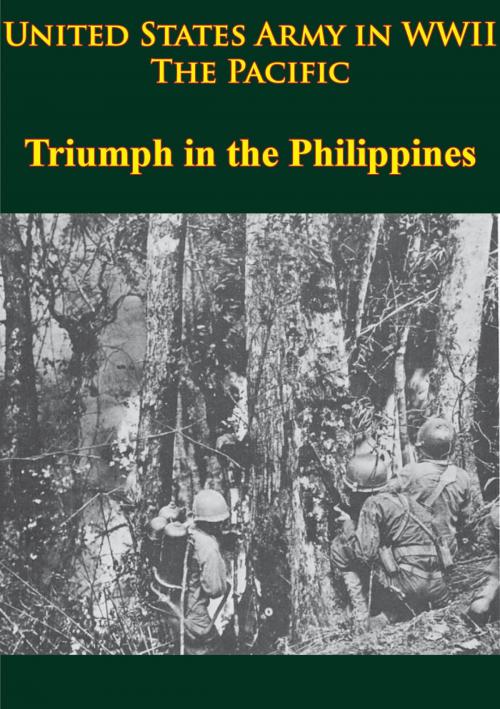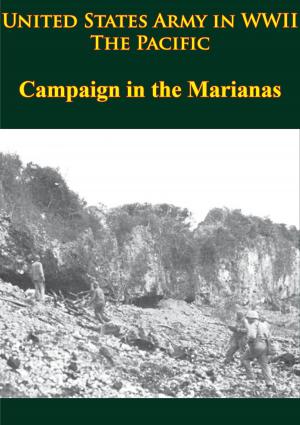United States Army in WWII - the Pacific - Triumph in the Philippines
[Illustrated Edition]
Nonfiction, History, Germany, European General, Military, United States| Author: | Robert Ross Smith | ISBN: | 9781782894063 |
| Publisher: | Verdun Press | Publication: | August 15, 2014 |
| Imprint: | Verdun Press | Language: | English |
| Author: | Robert Ross Smith |
| ISBN: | 9781782894063 |
| Publisher: | Verdun Press |
| Publication: | August 15, 2014 |
| Imprint: | Verdun Press |
| Language: | English |
[Includes 16 charts, 54 maps and 196 illustrations]
Triumph in the Philippines is the story of the largest joint campaign of the Pacific phase of World War II. Devoted principally to the accomplishments of U.S. Army ground combat forces and to the operations of major organized Philippine guerrilla units that contributed notably to the success of the campaign, the volume describes the reconquest of the Philippine archipelago exclusive of Leyte and Samar. The narrative includes coverage of air, naval, and logistical activity necessary to broad understanding of the ground combat operations. The strategic planning and the strategic debates leading to the decision to seize Luzon and bypass Formosa are also treated so as to enable the reader to fit the Luzon and Southern Philippines Campaigns into their proper perspective of the war against Japan.
For the forces of General MacArthur’s Southwest Pacific Area the reconquest of Luzon and the Southern Philippines was the climax of the Pacific war, although no one anticipated this outcome when, on 9 January 1945, Lt. Gen. Walter Krueger’s Sixth Army poured ashore over the beaches of Lingayen Gulf. Viewed from the aspect of commitment of U.S. Army ground forces, the Luzon Campaign (which strategically and tactically in-chides the seizure of Mindoro Island and the securing of the shipping lanes through the central Visayan Islands) was exceeded in size during World War II only by the drive across northern France. The Luzon Campaign differed from others of the Pacific war in that it alone provided opportunity for the employment of mass and maneuver on a scale even approaching that common to the European and Mediterranean theaters. The operations of Lt. Gen. Robert L. Eichelberger’s Eighth Army, both on Luzon and during the Southern Philippines Campaign, were more akin to previous actions throughout the Pacific, but the southern campaign, too, presented features peculiar to the reconquest of the Philippine archipelago.
[Includes 16 charts, 54 maps and 196 illustrations]
Triumph in the Philippines is the story of the largest joint campaign of the Pacific phase of World War II. Devoted principally to the accomplishments of U.S. Army ground combat forces and to the operations of major organized Philippine guerrilla units that contributed notably to the success of the campaign, the volume describes the reconquest of the Philippine archipelago exclusive of Leyte and Samar. The narrative includes coverage of air, naval, and logistical activity necessary to broad understanding of the ground combat operations. The strategic planning and the strategic debates leading to the decision to seize Luzon and bypass Formosa are also treated so as to enable the reader to fit the Luzon and Southern Philippines Campaigns into their proper perspective of the war against Japan.
For the forces of General MacArthur’s Southwest Pacific Area the reconquest of Luzon and the Southern Philippines was the climax of the Pacific war, although no one anticipated this outcome when, on 9 January 1945, Lt. Gen. Walter Krueger’s Sixth Army poured ashore over the beaches of Lingayen Gulf. Viewed from the aspect of commitment of U.S. Army ground forces, the Luzon Campaign (which strategically and tactically in-chides the seizure of Mindoro Island and the securing of the shipping lanes through the central Visayan Islands) was exceeded in size during World War II only by the drive across northern France. The Luzon Campaign differed from others of the Pacific war in that it alone provided opportunity for the employment of mass and maneuver on a scale even approaching that common to the European and Mediterranean theaters. The operations of Lt. Gen. Robert L. Eichelberger’s Eighth Army, both on Luzon and during the Southern Philippines Campaign, were more akin to previous actions throughout the Pacific, but the southern campaign, too, presented features peculiar to the reconquest of the Philippine archipelago.











![Cover of the book In the Ypres Salient, The Story of a Fortnight’s Canadian Fighting, June 2-16 1916 [Illustrated Edition] by Robert Ross Smith](https://www.kuoky.com/images/2013/march/300x300/9781782890638-oq1X_300x.jpg)
![Cover of the book THE ADMIRALTIES - Operations Of The 1st Cavalry Division 29 February - 18 May 1944 [Illustrated Edition] by Robert Ross Smith](https://www.kuoky.com/images/2014/august/300x300/9781782894568-Lip5_300x.jpg)

![Cover of the book German Northern Theater of Operations 1940-1945 [Illustrated Edition] by Robert Ross Smith](https://www.kuoky.com/images/2015/november/300x300/9781782899778-wjod_300x.jpg)
![Cover of the book The Dyess Story - The Eye-Witness Account Of The DEATH MARCH FROM BATAAN [Illustrated Edition] by Robert Ross Smith](https://www.kuoky.com/images/2014/august/300x300/9781782892694-WHns_300x.jpg)